GODDESS
----------------- Bulletin Message -----------------
From: Huntress of Truth~
Date: 11/01/2008
Thanks
Mama Serene
WITCHES WEB
Date: Jan 10, 2008 5:06 PM
ĀöMoon GoddessĀö
Date: Jan 10, 2008 6:26 PM
Āô~Michelle~Āô
Date: Jan 10, 2008 6:20 PM
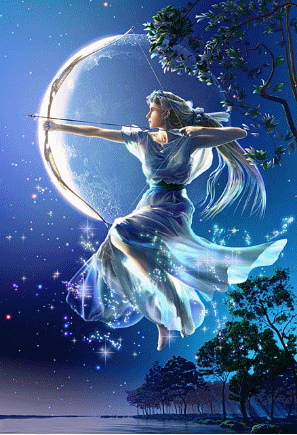
The Celtic Realm
The Celtic people regarded women highly so it is no wonder that some of their major Deities were female. In Celtic society, children took the name of their mother. Sex was not really a big deal and women with children drew a larger dowry than those with none. Choice of a mate was considered a woman's right. Red-haired women were sacred to the war Goddesses, as red was the color of life. The Celts believed in the triple aspects of Goddesses, depending on the region. These aspects represented the maiden, mother and crone.
Anu
Anu was the Goddess of Plenty and part of the triple aspect along with Badb and Macha. She was seen as the maiden and ruled over rites of fertility, health and prosperity. She was honored at Midsummer when fires were lit for her. She was also known as Dana and Anann.
Badb
Badb was known as a war Goddess and a sister of Macha. She ruled over the rites of wisdom and enlightenment and was associated with the cauldron.
Brighid
Brighid was known as the Poetess and associated with the Sabbat of Imbolc. She ruled over the rites of fire, fertility, the hearth, love, poetry and the feminine arts. Also known as Brigit, Brid and Brigid, she had an all-female priesthood at Kildare, with an ever-burning sacred fire.
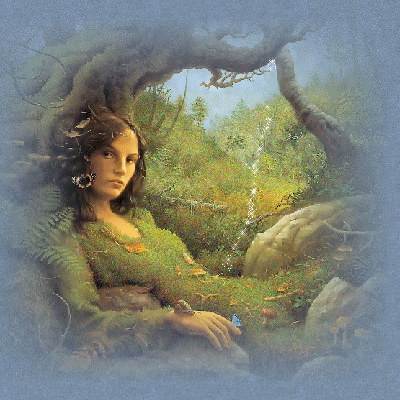
Macha
Macha was known as the Mother of Life and Death and honored at
Lughnassadh. She ruled over rites concerning sexuality, dominance over males and physical force, which is one of the reasons she was celebrated as a Goddess of War and Death.
The Morrigu
The Morrigu, also known as The Morrigan and Morrighan, was the Supreme War Goddess of the Irish Celts. She was a "shape-shifter", sometimes taking the form of a Raven. She reigned over war, fate and death and ruled over the rites of revenge, night and magick. She was also the Goddess of Rivers and Lakes and a patroness of witches and priestesses. She is sometimes associated with the Moon.

The Chinese Realm
When most people think of Goddesses, they may not think of deities from
ancient and modern China. In fact, the ancient Chinese worshipped many Gods and Goddesses, from natural forces to the ghosts of their ancestors. During China's many Dynasties, three religions developed that are still practiced today: Taoism, Buddhism and Confucianism. Christianity and Islam are also practiced to a lesser degree. After the Communist take-over in 1949, religion was officially banished. Only with changes in 1978, would organized religion once again be tolerated by the government. Many people in China still hold onto their ancient beliefs and it is not unusual to find altars honoring the Deities in homes.
Kuan-Yin
Kuan-Yin is perhaps one of the most famous Chinese Goddesses. She is the Goddess of Mercy and Compassion. The myth tells of a mortal Kuan-Yin, suffering a terrible life. After death, she became a Goddess and knew her quest would be to ease human suffering. Kuan-Yin is a Buddhist Deity, mainly worshipped in China.
Bixia Yuanjin
Bixia Yuanjin is a Goddess from the Taoist religion in China. She is the
Goddess of dawn, childbirth and destiny.

The Greco-Roman Realm
Since there are many, well-known Greek and Roman Goddesses that are very well represented all over the web, I have highlighted a few . The Greeks and Romans had many Deities in common, of course, with different names. However, they differed in their religious practices. The Greek's motive was to placate the anger or enlist the help of the Gods. Every day there was an occasion for some religious act with prayers to the Gods/Goddesses beginning and ending each day. The Romans also wanted to avoid the ill will of the Deities or enlist their aid for a specific purpose. The Romans were a bit more practical in their religious dealings. Celebration of the Deities was a family religious obligation undertaken that was usually held at the temple. In both the Greek and Roman religions, both men and women could be priests, but the Romans had quite a bit more structure in their religious organization and women were not as well represented at the policy-making level.
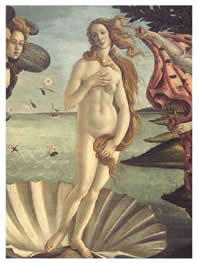
Aphrodite
Celebrated Moon Goddess whose rituals men were excluded from. She is the Goddess of Love, Beauty, Sex and Sensuality, Fertility and Renewal. Her sacred animals listed among them the dove and the swan. Love of Women, in whatever form, was sacred to Her. Closely related to Venus of the Romans, also the Goddess of Love, Beauty, Fertility, Sex, Renewal and Creation. Both were Virginal, which meant independence.
Artemis
Artemis was the Goddess of the Hunt and defender of Women. She is also
known as a Moon Goddess, representing the New Moon phase. Artemis reigns over Magick, Enchantment, Sports, the Hunt, Wild Animals and Dancing. Similar to Artemis is the Roman Goddess, Diana, Lady of Beasts, Goddess of the Hunt, Woods, Women and Childbirth. She too, is Goddess of the Moon, the "Queen of Heaven".

Gaia
She is known as the Universal Mother, Great Mother, Earth Mother. She represents all that is and all that will be. She is whole and all-knowing. Great Goddess of Motherhood, Healing, Divination and Dreams. Probably closest to Juno, Roman Primitive Earth Goddess in the Roman pantheon.
Hecate
Beautiful Goddess of the Underworld, Witchcraft and the Waning Moon. She is another Huntress, with all the secrets of nature at her command. She is the celebrated Goddess of the Witches, Magick, Spells, Victory and Wisdom. She was a shape-shifter who could control birth, life and death. In the Roman pantheon, also named Hecate, She is the Goddess of the Underworld, also known as the Crone and "Snake Goddess". She reigns over much the same areas as the Greek Hecate.
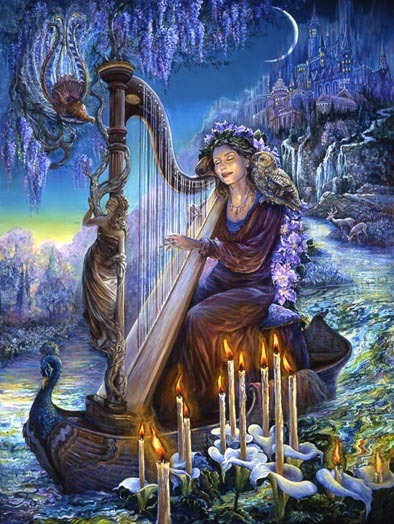
Minerva
She is the Goddess of War, a Virgin, which meant that she was independent. She was celebrated by artists, poets, sculptors and other artisans. She was the Supreme Goddess of Women's rights and freedoms. Her sacred animals were Owls and Horses. She is always represented in the Maiden aspect.
The Egyptian Realm
Probably the most complex and interesting Pantheon of all time. Much of it's history, though we know a lot of it, is still covered in mystery. This was a very old culture that lasted over three thousand years. It is interesting that in order to become Pharaoh, one must be born or marry into the ruling family of the Queen or Wife, meaning that inheritance of the throne came from the lineage of the mother. The Egyptians were famous for their belief in reincarnation and the elaborate way in which they prepared their dead for the next life. Magick and ritual were a part of everyday life and worship was a private concern. Listed below are just some of the Goddesses .

Bast
Also known as Bastet, this Goddess is the mother of all cats. She was pictured with the head of a cat and the body of a woman. She was also the Goddess of Fire, The Moon, Fertility, Joy, Music and Dance, Intuition and Healing. It is noted that to kill a cat in Egypt was punishable by death.
Hathor
Hathor is known as the "Mother Goddess" also "Queen of Heaven"; "House of Horus". She was pictured as a Goddess with a human form and a cow's head, or with a human head and cow's horns. She was believed to care for the dead and carried them to the afterworld. She is known as the protectress of Women and reigned over the Moon, Motherhood, Beauty, Joy, Cosmetics, Wine and Beer, Nature, Prosperity and Family, among other things. Of course, the cow was sacred to her.
Isis
Perhaps the most popular Goddess, and rightfully so. Isis was the Supreme
Goddess, the "Great Goddess", the "Giver of Life". She was a part of the "Holy Trinity", with Horus and Osiris. Isis was pictured with dark hair, blue eyes and light skin. She is sometimes shown with her arms as wings which signified her as a protector. She reigned over Marriage, Magick, Purification, Reincarnation, Womanhood, Civilization, The Arts, and Healing. She was also the patroness of Priestesses.

Neith
Also known as Neit, Net and Nit, this Goddess symbolized the Huntress. She was Goddess of war and the hunt. She reigned over the feminine arts as well as Herbs, Magick, Healing, Rituals, Medicine, Weapons and Meditation. She is pictured with a bow and arrows.
Ta-Urt
This Goddess was pictured as a hippo with huge breasts. She was known as the Goddess of Childbirth and Maternity. Known also as the Goddess of Revenge and Protection in her dark aspect. The hippopotamus was sacred to her.
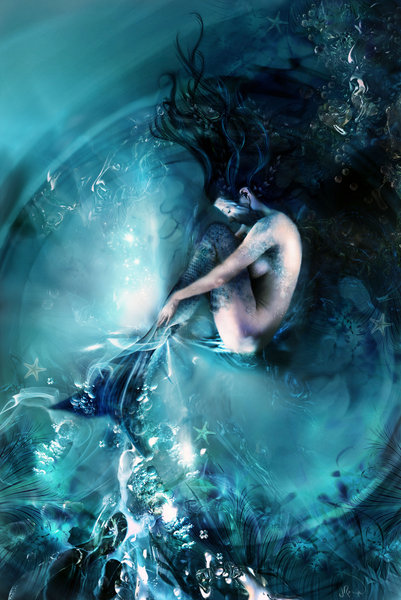
Goddess bless,
M~









